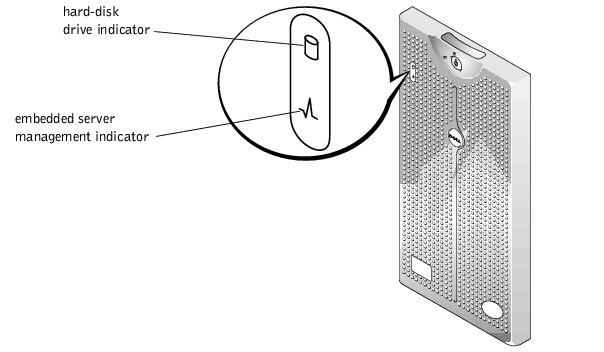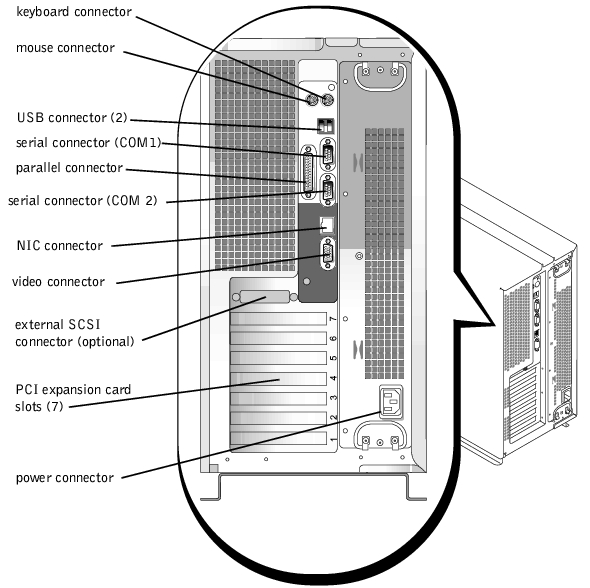Back to Contents Page
Dell™ PowerEdge™ 2500 Systems
User's Guide
 System Orientation
System Orientation
 Front-Panel Indicators and Features
Front-Panel Indicators and Features
 Back Panel Features
Back Panel Features
 System Features
System Features
 Supported Operating Systems
Supported Operating Systems
 Power Protection Devices
Power Protection Devices
 Other Documents You May Need
Other Documents You May Need
 Getting Help
Getting Help
The Dell™ PowerEdge™ 2500 system, which has one- or two-way-capable Intel® Pentium® III microprocessors, is a full-featured server that can be mounted in either a rack or a tower form factor. The PowerEdge 2500 provides a robust, reliable, platform on which both large and small customers can deploy their mission-critical applications.
This section describes the major hardware and software features of the system, provides information about the indicators on the system's front panel, and discusses connecting external devices to the system. It also provides information on obtaining assistance from Dell.
When following the procedures in this guide, assume that the locations or directions relative to the system are as shown in Figure 1-1.
Figure 1-1. System Orientation

Two indicators are located on the front panel: the hard-disk drive indicator and the ESM indicator. The ESM indicator flashes amber when the system needs attention. The amber ESM indicator indicates a problem with the power, the fan, the temperature, hard-disk drives, or the PCI expansion cards. The power supplies and hard-disk drives also have indicators which can be seen when the bezel is removed. The CD-ROM and diskette drives have green activity indicators.
Figure 1-2. Bezel Indicators

Figure 1-3. Front-Panel Features

Figure 1-4 shows the back-panel features of the system version with the nonredundant AC power supply.
Figure 1-4. Back-Panel Features

When connecting external devices to your system, follow these guidelines:
- Check the documentation that accompanied the device for specific installation and configuration instructions. For example, most devices must be connected to a particular connector to operate properly. Also, external devices usually require you to install device drivers before they will work. Device drivers are normally included with your operating system software, or with the device itself.
- Always attach external devices while your system is turned off. Then turn on any external devices before turning on the system unless the documentation for the device specifies otherwise. (If the system does not seem to recognize the device, try turning on the system before turning on the device.)
For information about enabling, disabling, or configuring I/O ports and connectors, see "Using the System Setup Program."
Your PowerEdge system offers the following features:
- One or two Intel® Pentium® III microprocessors with an external bus speed of 133 MHz and an internal operating speed of at least 933 MHz
- Front side bus speed of 133 MHz
- Level 2 cache of 256 KB
- Support for SMP, which is available by installing additional microprocessors. SMP greatly improves overall system performance by dividing microprocessor operations among the independent microprocessors. To take advantage of this feature, you must use an operating system that supports multiprocessing.
 |
NOTE: If you decide to upgrade your system by installing a second microprocessor, you
must order the microprocessor upgrade kits from Dell. Not all versions of the
microprocessor will work properly as additional microprocessors. The upgrade kit from Dell
contains the correct version of the microprocessor as well as the correct instructions for
performing the upgrade. Both microprocessors must have the same internal operating
frequency and cache size.
|
- A minimum of 128 MB of system memory, upgradable to a maximum of 4 GB by installing combinations of 64-, 128-, 256-, 512-MB, or 1-GB registered PC-133 SDRAM memory module pairs in the six memory module sockets on the system board.
- Support for up to eight 1-inch, internal, hot-pluggable Ultra3 SCSI hard-disk drives (six 1-inch hard-disk drives via a 1 x 6 SCSI backplane board, and two 1-inch hard-disk drives via an optional 80-pin SCA 1 x 2 SCSI backplane board).
- Up to three hot-pluggable, 300 W power supplies in a 2 + 1 redundant configuration.
- Four redundant, hot-pluggable system cooling fans.
The system board includes the following built-in features:
- Seven PCI slots located on the system board. PCI slots 1 and 2 are 64-bit, 66-MHz slots; PCI slots 3 though 5 are 64-bit, 33-MHz slots. Slots 6 and 7 are 32-bit, 33-MHz slots. Slot 7 can be used for the optional DRAC or other PCI-compatible options.
- An integrated VGA-compatible video subsystem with an ATI RAGE XL video controller. This video subsystem contains 8 MB of SDRAM video memory (nonupgradable). Maximum resolutions are 1024 x 768 x 256 colors (noninterlaced). In 800 x 600-pixel and 640 x 480-pixel resolutions, 16.7 million colors are available for true-color graphics.
- Embedded dual-channel Ultra3 SCSI controller.
- An optional integrated dual-channel PERC 3/Di that supports RAID levels 0, 1, 5, and 10. The Ultra3 SCSI host adapter can become RAID capable with the addition of the PERC 3/Di.
- An integrated Intel 10/100 NIC, which provides an Ethernet interface.
- Server management circuitry that monitors operation of the system fans as well as critical system voltages and temperatures. The server management circuitry works in conjunction with the Dell OpenManage™ Server Agent.
Standard systems include a IDE CD-ROM drive and diskette drive installed in the externally accessible bays.
The following software is included with your Dell system:
- A system setup program for quickly viewing and changing the system configuration information for your system. For more information on this program, see "Using the System Setup Program."
- Enhanced security features, including a user password and a supervisor password, available through the system setup program.
- Dell Diagnostics for evaluating your system's components and devices. For information on using the system diagnostics, see "Running the Dell Diagnostics" in your Installation and Troubleshooting Guide.
Dell supports the following operating systems for use on your PowerEdge system:
- Microsoft® Windows NT® 4.0 Server
- Microsoft Windows® 2000 Server and Advanced Server
- Red Hat Linux 7.x
- Novell® NetWare® version 5.x
A number of devices are available that protect against power problems such as power surges, transients, and power failures. The following subsections describe some of these devices.
Surge protectors are available in a variety of types and usually provide a level of protection commensurate with the cost of the device. Surge protectors prevent voltage spikes, such as those caused during an electrical storm, from entering a system through the electrical outlet. Surge protectors, however, do not offer protection against brownouts, which occur when the voltage drops more than 20 percent below the normal AC line voltage level.
Line conditioners go beyond the overvoltage protection of surge protectors. Line conditioners keep a system's AC power source voltage at a fairly constant level and, therefore, can handle brownouts. Because of this added protection, line conditioners cost more than surge protectors—up to several hundred dollars. However, these devices cannot protect against a complete loss of power.
UPS systems offer the most complete protection against variations in power because they use battery power to keep the system running when AC power is lost. The battery is charged by the AC power while it is available, so once AC power is lost, the battery can provide power to the system for a limited amount of time—from 15 minutes to an hour or so—depending on the UPS system.
UPS systems range in price from a few hundred dollars to several thousand dollars, with the more expensive units allowing you to run larger systems for a longer period of time when AC power is lost. UPS systems that provide only 5 minutes of battery power let you conduct an orderly shutdown of the system, but are not intended to provide continued operation. Surge protectors should be used with all UPS systems, and the UPS system should be UL safety-approved.
Besides this User's Guide, the following documentation is included with your system:
- The Setting Up Your System sheet provides general instructions for setting up your system.
- The Dell OpenManage Server Agent documentation describes the server management software, including alert messages issued by the software.
- The Dell PowerEdge 2500 Systems Installation and Troubleshooting Guide describes how to upgrade or troubleshoot your system.
- The Dell PowerEdge System Information document for important safety, regulatory, and warranty information.
- The Dell PowerEdge 2500 Systems Rack Installation Guide describes how to unpack and set up the PowerEdge 2500 rack and install systems in the rack.
You may also have one or more of the following documents.
 |
NOTE: Documentation updates are sometimes included with your system to describe changes to
your system or software. Always read these updates before consulting any other documentation
because the updates often contain the latest information.
|
- Operating system documentation is included if you ordered your operating system software from Dell. This documentation describes how to install (if necessary), configure, and use your operating system software.
- Documentation is included with any options you purchase separately from your system. This documentation includes information that you need to configure and install these options in your Dell system. Installation instructions for the options are included in this User's Guide.
- Technical information files—sometimes called "readme" files—may be installed on your hard-disk drive to provide last-minute updates about technical changes to your system or advanced technical reference material intended for experienced users or technicians.
If at any time you don't understand a procedure described in this guide or if your system does not perform as expected, Dell provides a number of tools to help you. For more information on these help tools, see "Getting Help" in your Installation and Troubleshooting Guide.
Back to Contents Page
 System Orientation
System Orientation Front-Panel Indicators and Features
Front-Panel Indicators and Features




